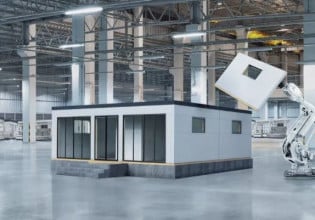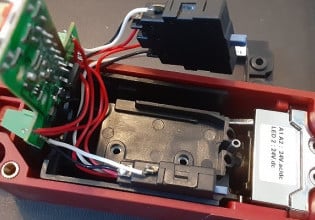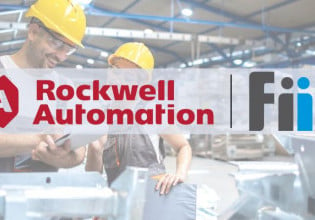Introduction to Industrial Sensors
Industrial sensors can be found in nearly every modern industrial process, regardless of complexity. Learn the history, evolution, and variety of sensors that make manufacturing the modern marvel we see today.
Modern manufacturing processes are complex, requiring multiple steps that must work together to create a final product. These steps may be simple, or they may be individual sub-processes in themselves. In many cases, complexity raises the necessity for automation, and with automation comes the architecture of hardware and software components that facilitate it. Industrial sensors are at the top of the list of components needed in an automated process.

Figure 1. A machine vision system. Image used courtesy of Cognex
Industrial sensors perceive a physical quantity at the input and send a corresponding electrical signal at the output. Sensors are transducer devices because they convert energy from one form to another. As the name suggests, sensors can sense the world around them and convert that input into something that a computer or a process controller can understand.
Industrial sensors can be found in nearly every modern manufacturing process, regardless of complexity. As a result, it is nearly impossible to conceive an automated system without sensors.
Evolution of Sensor Technology
The earliest examples of sensing technology can be found as far back as the nineteenth century with the invention of the bimetal thermostat by Warren Johnson. The next several decades saw the arrival of some of the first forms of discrete sensors, including limit switches, photoelectric sensors, and magnetic devices.
The first analog sensors originated in the mid-twentieth century. American inventor Samuel Bagno created the first motion sensor in the 1940s, based on technology developed during the second world war. The first infrared sensors were developed around the same time. Other sensors, such as ultrasonic, humidity, gas, and vibration, were created in the following decades.

Figure 2. Smart sensors enable wireless monitoring. Image used courtesy of Adobe Stock
As we know, humanity has already gone through three industrial revolutions and is in the middle of its fourth revolution. New benchmarks in sensor technology have been developed in each of these eras. The first revolution brought mechanical sensors, the second brought electrical sensors, and the third brought electronics. Finally, the fourth revolution, Industry 4.0, has given birth to smart industrial sensors.
Smart sensors are fundamentally the same as their earlier counterparts, with the big difference being connectivity. Smart sensors can share measurement data to a centralized system and into the cloud.
Industrial Sensor Types
There are different ways to classify industrial sensors. In terms of the type of signal processing, the following categories exist:
-
Electrical: voltage, current, resistance
-
Optical: reflective, laser
-
Thermal: temperature, thermal conductivity
-
Magnetic: inductive, magnetic field
-
Radiation: ultrasonic, acoustic, infrared
-
Chemical: gas, humidity
-
Mechanical: flow rate, pressure, vibration, velocity

Figure 3. Different types of industrial sensors. Image used courtesy of Banner Engineering
In addition, sensors can be categorized according to how they are placed. Online sensors are those where the material or process flows through or past the sensor. Offline sensors are for sampling and quality control.
Offline sensors can also be found inside measurement tools, since nearly every hand-held meter or instrument contains one of more sensors that can give valuable insights into processes and problems.
New sensors are still being developed continuously. However, only a few are truly successful as marketable products. The expected characteristics of reliability and simplicity offered by established sensor types and brands usually outweigh the benefits of new sensing technologies that have yet to be proven in the market.
Sensor Measurement Model
Fundamentally, every industrial sensor is designed to detect measurable changes experienced by a physical quantity. Physical quantities can be magnetic fields, temperature, pressure, frequency, or light conditions. These measurable changes are processed by the sensor and converted to an output. Outputs can be simple signals or complex data sets.
Sensors are reliable, and that is because the most important requirement is repeatability. Ideally, a sensor must always produce the same output upon the same physical input value.
Another requirement is that sensors provide a linear relationship between input and output. The relationship between the input and the output can be described using the straight-line equation as follows:
$$y=(m \cdot x) + b$$
$$Output = (Gain \cdot Input) + Offset$$
The gain is the factor that defines the rate of change, while the offset is the distance to the zero point of the line. One of the goals of sensor calibrations is to bring the offset as close to zero as possible to represent that the “zero value” of the sensor matches the “zero value” of the physical quantity being measured.
Sensor outputs are usually in the form of a voltage or current signal. Typical output ranges in industrial automation include 0 to 10 V, 0 to 5 V, 0 to 24 V, and 4 to 20 mA. To provide meaning, these outputs are then processed and converted to the desired unit of measurement (degrees, meters, presence/absence, depending on the application).

Figure 4. The traditional process control loop.
What’s So Important About Sensors Used in Automation?
We have mentioned that industrial sensors are vital elements of automated systems. But why are they so important? Let us use an analogy comparing a controlled system with the human nervous system. The brain is a central controller that receives inputs from billions of nerves. Nerves are terminals that capture information about the outside world and feed it to the brain.
Industrial sensors are just like human nerve terminals. Without them, the industrial process is blind to itself and its environment. In the traditional control loop model, sensors are the key devices that provide feedback about the process.
*For further information about feedback and control loops, visit the Control textbook chapter about Basic Process Control Strategies.






